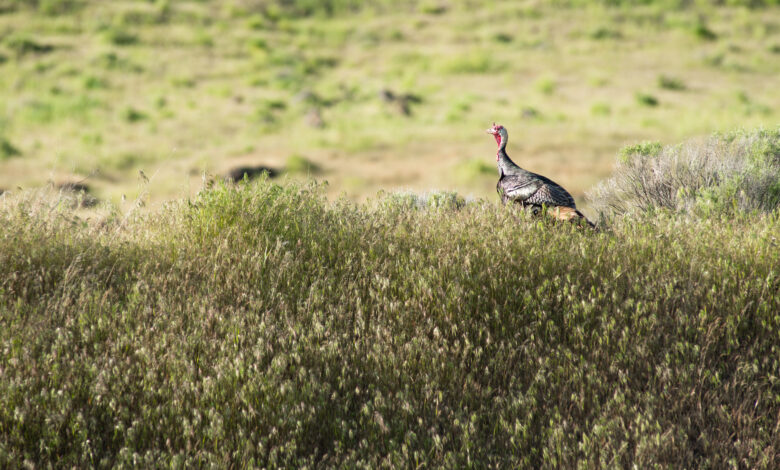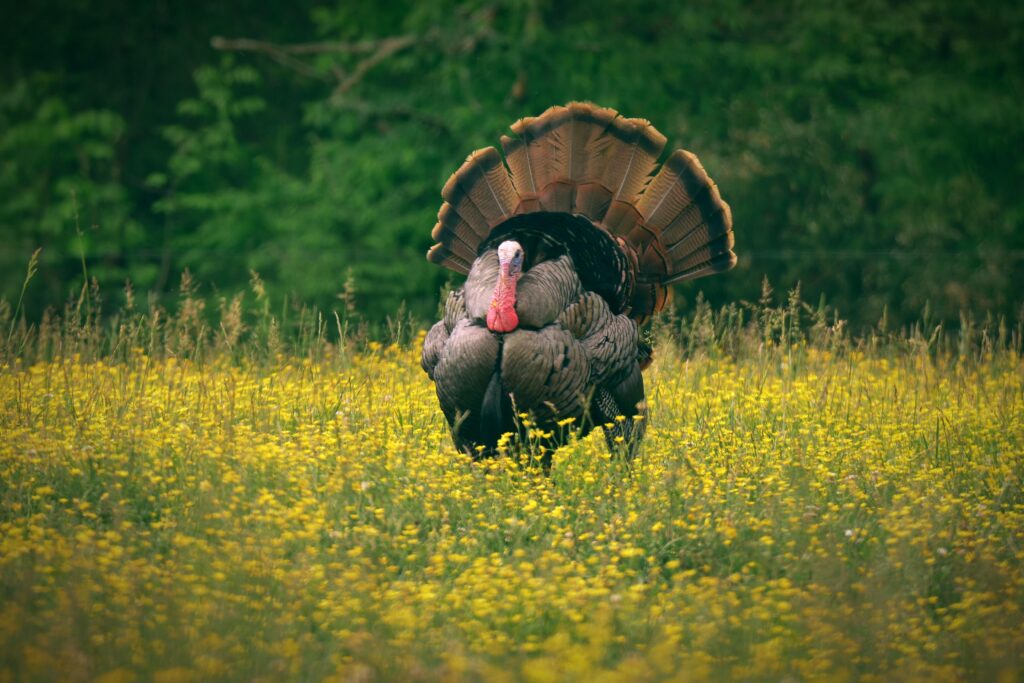How to Scout for Turkeys: A Comprehensive Guide

When it comes to hunting spring turkeys, remember that it is the season for change. Turkey flock dynamics are changing and as the season progresses their behavior will be guided by two key factors- mating and pre-nesting.
To make the best use of the conditions you need to know how the birds are using the landscape and predict how and where they will move. This is why scouting is so important for harvesting that tight-lipped gobbler in the opening weekend.
To help you make the most from a turkey scouting trip we will discuss the following.
- The best times for turkey scouting
- How to find turkeys by identifying their signs
- Roosting
- And more
Check out Art and Michelle’s latest episode of Own The Season to learn how they track and scout turkeys!
When to Scout for Turkeys
What I love about turkey hunting is you need not carry much gear or the turkey hunting essentials. Traveling light inside the woods allows you to move fast and stay hidden inside the tree line.
Winter Scouting
Apart from hitting the shooting range with your shotgun, winter is a good time to spot large turkey flocks. In winter, turkeys are looking for the best combination of food and a comfortable roosting location. Usually, these areas are not far from their favorite spring habitats.
Scouting will give you a general idea about where to find them. But keep in mind that turkeys may change their movement patterns to match the weather.
Turkey flocks are easier to find in winter and I have spotted a few even from the road on the warmer days. Since the trees are barren, glassing from the road is easier. By observing these groups you will know about the overall numbers and number of toms.
Tracking their footprints on the snow can lead you to roosting spots and food sources. This will allow you to identify the best ambush points in advance.
Pre-season Scouting
Just a week or two before the season’s opening day is a great time to scout for turkeys. You can track the gobbler you have spotted during the winter to get a clear idea of its daily movements and zero in on the roost. Once you have mapped their route in and out of the roost, you can refine your plans for the season.
Chances are that other hunters will be following the same pattern. This is where pre-season scouting can help you to move off the beaten path and avoid the crowd. By knowing the terrain, you can select a safe place to set up early in the morning without risking spooking the birds.
In-season Scouting
You are sitting in the same spot for hours, but the calls are not working and there is no sign of the tom. Sounds familiar?
Then, it is time to adapt and start scouting for a better location that will work rather than wasting your hunting time in barren spots. Use your pre-season scouting knowledge to head to an area that offers better chances.
I use calls sparingly while searching for a new location Quite simply, I do not want to get too aggressive before knowing the details of a tom. If there is no response, keep moving till you hear a gobble. A two-person setup can work better in scouting different areas and exchanging ideas to decide the best one.
Identifying Turkey Signs
Reading turkey signs is one of the best ways to understand their daily routine. Here are the signs that you need to read.
Tracks
Turkey tracks are easily found on soft ground or the snow and they can indicate the path they have taken between the roosting spot and feeding area. Knowing their travel routes gives you a better chance of finding the best ambush location. However, following older tracks may not bring you to the right area and the turkeys may have shifted location.
In the case of a boss gobbler, you will find the middle toe to be distinctly long. For hens and jakes, it is smaller. In some cases, a strutting tom may leave wing drag marks on both sides of his tracks during turkey mating season. That means you are in his strut zone.
Scat
The droppings help you to know the gender of the bird. Gobbler dropping is around two inches long with one end shaped like a small hook or a “J”. On the other hand, hens leave behind a single dropping, that often looks like popcorn, in the form of a pile.
Scratching
Turkey scratches on the ground can be found in the turkey woods when the birds are looking for bugs in the forest bed. Listen closely, and you will be able to identify the scratching noise from other sounds. When you come across a scratch mark, check the direction where the leaves or other debris are piled up. Generally, the turkeys will be heading in the opposite direction of that pile.
Dusting sites
When turkeys take a dust bath, you will find scratched-up earth on the forest floor. A turkey using the same spot frequently will create a shallow depression on the ground. Make sure to confirm that this is a turkey sign by checking for tracks around the area. These are great ambush points to set up and make use of your calling skills.
Locating Turkey Roosts
Roost sites or sleeping spots are necessary for wild turkeys, especially during harsh winter conditions. Plus, a roost also keeps a wild turkey safe from night-time predators. Roosting a turkey is a great way to target him once he flies down the next morning.
Most roosting sites are in secluded locations that are often difficult to approach. Tall trees with long horizontal branches that are higher off the ground, preferably standing next to a clear landing spot. Young hardwood or trees with heavy vegetation around them are not preferred as they make it hard to spot predators.
Basswood, black ash, American beech, American elm, and white cedar are some trees that turkeys prefer. Ideally, a 40 to 50 feet tall tree is a good option for turkeys. Locations like ridge tops and gullies with large oaks, or river bottoms with tall cottonwoods are some common sites.
The best way to locate a roost site is to use your e-scouting tools and check for suitable locations. Next, head to the spot in the early morning hours and listen for gobbles.
One effective way is using locator calls like that of an owl or a crow works well during the evening hours. I have found coyote howls useful as well. The locator calls can generate a shock gobble that helps in pinpointing the location.
Once you have identified the roost, the task is only half done. You need to set up in the right spot and bring the bird towards you the next morning. Keeping a distance between 100 to 200 yards from the roost is a good idea. Try to arrive before sunrise, stay stealthy, and do not call aggressively.
Now, the turkey may not fly down in your direction, but if it does, remember, that these birds can fly down surprisingly quickly. So, using a diaphragm call and keeping your hands free is a good idea.

Identifying Turkey Travel Routes
In my years of turkey hunting, I have learned that turkeys are creatures of habit. So, they mostly use the same travel pattern, if not the exact same route. Knowing the natural travel route of the tom will help you to set up your best turkey-hunting decoys.
Generally, turkeys prefer the path of least resistance. That makes following the exact travel route of a longbeard on a wide flat ground challenging. The birds can use multiple pathways to move towards the roost or feeding ground. In comparison, turkey travel routes are more predictable on hilly terrain with plenty of obstacles.
The first time I saw deer tracks and droppings while following a turkey, I was somewhat surprised. But, turkeys use deer trails and many hunters use this fact to kill two birds with one stone.
You can also expect the birds to travel along old logging roads and oak flats. These are open areas where they can spot approaching dangers while attracting the attention of the females as well. Beyond that, turkeys prefer to travel along ridge tops while moving between two points.
If you find pinch points in the travel route of a tom, great. Your chances of harvesting have just gone up. Funnels, fence gaps, and other pinch points are excellent spots for an ambush.
Turkey Scouting Tips
Here are some effective turkey hunting tips that we have gathered after discussing with some pro hunters.
- Turkeys are cautious by nature and have super sharp eyes. So, stealth is a must while turkey hunting. Staying hidden from their eyes is not easy and pre-season scouting is a great way to practice moving stealthily through the woods.
- Calling to birds during a pre-season scouting trip should be avoided. The longbeard might discover you and all you have done is educate him of your hunting tactics. Shock calls are the only option you should use.
- Using an app or an aerial mapping tool are two great ways to increase your chances even before you set boots on the ground.
- It is important to put together all the information you have collected from the scouting trips to make the best use of your time. Make sure that each phase of the plan matches with the turkey behavior patterns during that part of the day. Start by hitting the roost area early in the morning and then move to the feeding and strutting zones. At the end of the day, head back to the roost area to complete the full circle.
Final Thoughts
Hope that helps in answering the question– how to locate turkeys by scouting.
Finding turkeys during the season can be a difficult task, especially if you are starting out. That makes scouting an important aspect of turkey hunting that you cannot afford to overlook. At the same time, scouting is not to be taken lightly as you do not want to spook the birds.
Just like hunting, scouting requires knowledge, patience, and excellent observation skills. So, understanding the bird’s behavior will help boost your hunting skills as well.
The simplest tip we can provide is to just be where the turkeys are naturally and you’ll have no problem finding them. Good luck!


